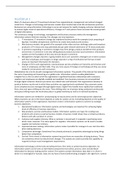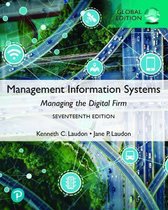Hoofdstuk 1
Most of a business value of IT investments derives from organizational, management and cultural changed
inside firms. Changes in technology and business models have transformed social life and business practices.
Businesses are using information technology to sense and respond to rapidly changing customer demand and
to achieve higher levels of operational efficiency. Changes in IT and systems have increased the annual growth
of digital information.
The continuous change in technology, management and business processes makes the management
information systems field very exciting. Five changes are very important:
1. IT innovations; IT innovations change the traditional business world for example cloud computing of
big data. It enables entrepreneurs and firms to create new products and services.
2. New business models; the growth of for example online video services challenge cable and broadcast
producers of TV shows and may potentially disrupt cable network dominance of TV show production.
3. E-commerce expanding; e-commerce changes how firms design, produce and deliver their products
and services. E-commerce is not only selling physical products but also social commerce. Information
systems are the foundation of this new services-based e-commerce.
4. Management changes; Business is going mobile and so are customers. Managers are in direct contact
with their employees and mangers no longer operate in a fog of confusions but the have instant
access to important information for decisions.
5. Changes in firms and organizations; new businesses put less emphasis on hierarchy and structure and
more on employees and their skills. They are more aware of changes in technology and they use social
media for conversations with consumers.
Globalization has a lot do do with management information systems. The growth of the Internet has reduced
the costs of operating and transacting on a global scale. Information systems enable globalization.
A digital firm is a firm in which all of the organization’s significant business relationships with customers,
suppliers and employees are digitally enabled and mediated. Core business processes are accomplished
through digital networks. Business processes are related tasks and behaviors that organizations develop to
produce business results and in which these activities are organized and coordinated. Key corporate assets
(core competencies) are managed through digital means. Digital firms handle more rapidly than traditional
firms; time and space shifting are the norm. Time shifting refers to a business being conducted continuously
and space shifting means the work takes place in a global workshop as well as in national boundaries.
Information systems are needed for conducting day-to-day business and for achieving business objectives.
What a business can do in the future depends on what its system can do. Everything depends on the quality of
information systems in the organization. Businesses invest in information systems to achieve six strategic
business objectives;
1. Operational Excellence: Information systems and technologies are important for achieving higher
levels of efficiency in business operations.
2. New products, services and business models: Information systems are major for creating new
products and services as well as business models. A business model shows how a company produces,
delivers and sells a product or service.
3. Customer and supplier intimacy: When a customer is served well, it responds in purchasing more
which raises revenues. The same applies for suppliers. Information systems can be used to enable
supplier and customer intimacy.
4. Improved decision making: Information systems make it possible for managers to use real-time data
when making decisions.
5. Competitive advantage: Sometimes firms already achieved a competitive advantage by doing things
better than competitors.
6. Survival: Firms invest in information systems because there are necessities of doing business. These
are sometimes driven by industry-level changes. The systems are used to provide the capability to
respond to these record management requirements.
Information technology is all the hard and software that a firm need, to achieve business objectives. An
information system can be seen as interrelated components that collect, process, store and distribute
information for decision making and for control. The systems contain information; data that is in a form in
which it is meaningful for humans. Data are raw facts of events before being arranged in the right form. Control
,operations, analyze problems and creating new products or services are three activities that need to be done.
Input collects raw data, processing puts this in the right form and the output transfers the information to the
right people. Information systems require feedback which is output that is returned to members of an
organization to help them evaluate the input.
Computers and software programs are the base of information systems because they provide the equipment
for storing and processing information. They have operating instructions. It is important to know how the
computer programs work for designing solutions. But to understand
information systems, knowing the technology is not enough. You have to
understand the problems that need to be solved and their design
elements and organizational processes.
Information systems consists of technology, organizations and
management. Information systems literacy is
the understanding of these elements of information systems. Computer
literacy is focused on the knowledge of computer technology.
Managements information systems try to achieve the information
systems literacy and it deals with behavioral and technical issues
surrounding the development, use and impact of information systems.
1. Organizations: People, structure, business processes and culture
are the key elements for an organization. The structure reveals a
division of labor and authority and hierarchy are organized as a
pyramid. Senior management makes strategic decisions about
products and ensures financial performance. Middle management
carries out the programs and plans and operational management
monitors activities of the business. Knowledge workers design and
create new knowledge and data workers assists with scheduling
and communication. Production of server workers produce the
product. The major business functions are sales, marketing,
production and finance. Work is coordinated through the hierarchy
and through business processes which include formal rules.
Information systems automate many business processes. Each
organization has a culture which is a set of assumptions and ways of doing things. Conflict between
levels and specialties are the basis or organizational politics.
2. Management: The job is to make sense out of situations, make decisions and formulate action plans to
save problems. Managers must exercise leadership and create new products and services. Creative
work driven by knowledge and information is important for managers. Information technology can
help with designing and delivering new products.
3. Information technology: Computer hardware is the physical equipment for input, processing and
output. It consists of computers, devices and telecommunication devices. Computer software consists
the preprogrammed instructions and they coordinate computer hardware components. Data
management technology consists of the software of data on physical storage media. Networking and
telecommunication technology consists of physical devices and software and links pieces together to
transfer data. A network links two or more computers. The Internet is a network which is a network of
networks to connects many networks. It has internal uses which makes it a internal corporate
network; they are called intranets. Extranets are private intranets which are used to coordinate
activities by firms. The World Wide Web is a service provided by the Internet that accepts standards
for storing, retrieving and formatting information on the internet. The information technology
infrastructure is the technologies and the people that
run and manage them. It provides the platform on
which information systems can be build.
Information systems are important for the business.
Information systems can increase revenue or decrease costs by
providing information for decision making. Every business has
an information value chain in which raw information is
systematically required and transformed through stages that
add value to that information. The organizational and
, managerial nature of information systems are called by the business perspective.
Complementary assets can show why some information technologies return good outcomes and others do not.
Supportive values, structures and behavior patterns are needed besides information technology investments.
Complementary assets are assets required to derive value from an investment. Firms that invest in new
business models, training, management and so on, receive better returns. These investments are called
organizational and management capital. A supportive business culture, a business model, efficient processes,
authority and a strong information system development team are key organizational complementary
investments. Important managerial complementary assets are strong senior management, interactive systems,
teamwork and a flexible management culture. Social investments are made by the society and can be the
internet and educational systems and so on.
An information system is a sociotechnical system which requires an organizational, social and technical
approach. Adopting this helps to avoid a purely technological approach.
The technical approach studies the physical technology and formal capabilities of systems. Computer science
and operation research focus on this. Behavioral approached contribute to important concepts and methods
and make design and implementation more understandable. It does not ignore technology but if concentrates
on changes in management and behavior.
The actors, suppliers, business firms, managers and employees and the legal/social/cultural context form the
management information system. This study of this system focuses on computer-based information in firms. It
focuses on computer, management science and operations research and also developing system solutions.
Slides College 1
ICT has a prominent role in increasing value and revenue in any
business. O-ICT introduces us with the interplay between
organizations, business processes and information and
communication technology. By studying organizations, the
context where ICT operates becomes clear and with
understanding processes, we can understand how they work.
By understanding how ICT helps organizations, you can
improve them. Modelling techniques can analyze the whole
interplay. Information systems are a part of information
technology which is a part of ICT.
Information systems are transforming businesses by emerging
with the mobile digital platform and growing the use of big data and cloud computing. It has globalization
opportunities; the internet reduced costs of operating globally which increased foreign trade. It has challenges
but also opportunities.
ICT capital investment is a percentage of total non-residential gross fixed capital formation.
Cloud computing is more important and a growth in software as a service and the use of mobile digital
platforms can be seen in the field of technology. Managers nowadays use online collaboration and social
networking software to improve knowledge sharing, coordination and collaboration. Business intelligence
applications accelerate by making strategic use of data. Web 2.0 applications are widely adopted by firms and
organizations. The telework gains momentum in the workspace and business ecosystems are a co-creation of
business value.
Growing independence between ability to use information technology and the ability to implement corporate
strategies and achieve corporate goals is what describes a digital firm. Besides the 6 strategic business
objectives, becoming more responsible is another important one. Becoming more responsible is important for
internal and external forces. Internal forces apply to the relevant stakeholders and external forces apply to
marketing purposes and new regulations.
Managers must use forecasts, guesses and luck without accurate information which results in poor response
time or poor outcomes.
Hoofdstuk 2
Businesses must deal with many different pieces of information and they must organize work activities that use
this information. Information systems help firms with managing all the information, making decisions and
improve business processes.





